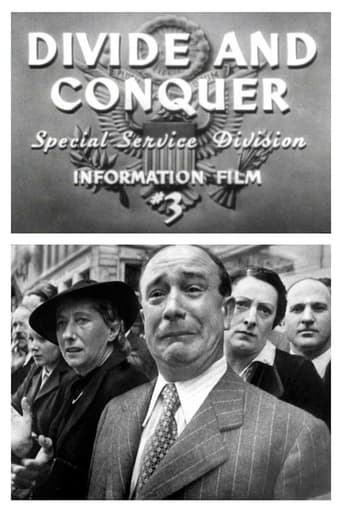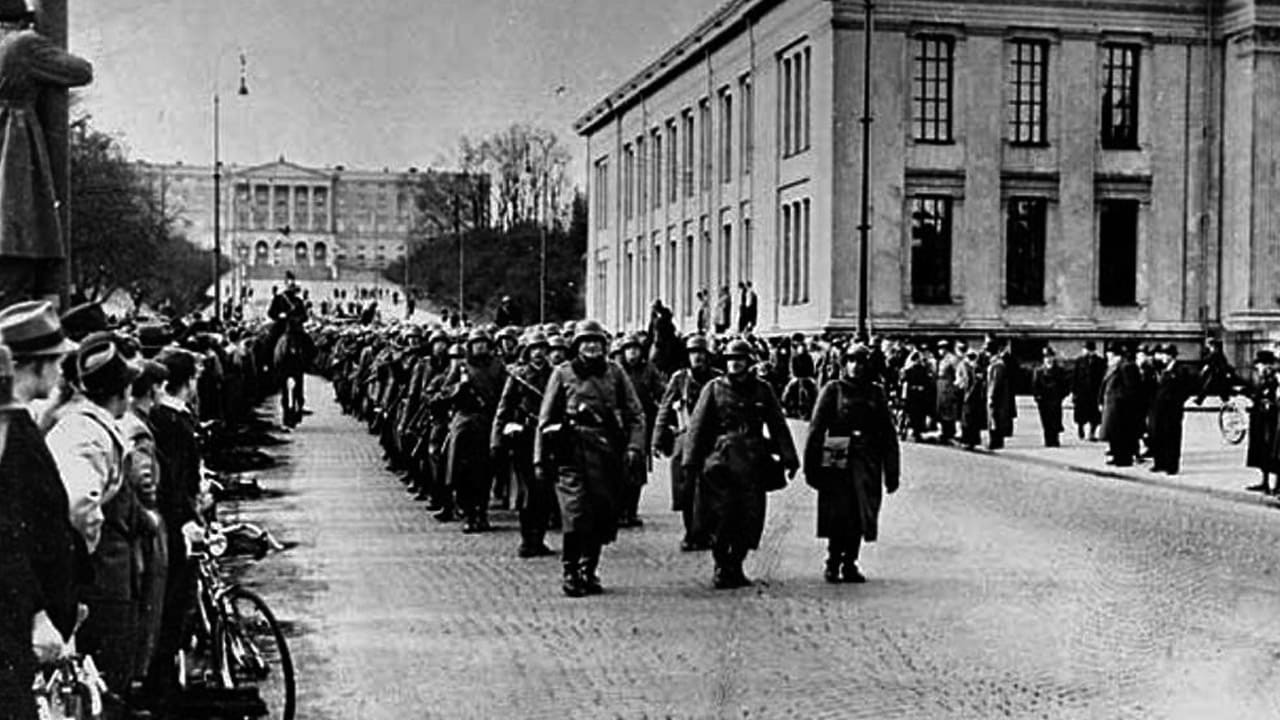chaswe-28402
Propaganda, presumably, can be defined as telling the story of a conflict from one side only. However, there is honest propaganda, and false propaganda. This film may be described as propaganda, but it seems to me fundamentally honest. The Germans are not flattered, but neither are the allies. Hitler was not described as a house painter, for instance, as is the case in other DVDs of this series, here named World in Conflict, subtitled Why We Fight.Instead, this description of Hitler's Blitzkrieg through Europe and Scandinavia, is admirably clear, and well narrated. It follows the pattern of a military sitrep, or situation report, and explains how the Germans avoided the Maginot line with their carefully structured plan of attack on the West, after having come to a deceptive and treacherous non-aggression pact with Russia.The blunder of Hitler's terminally megalomaniac declaration of war against the US, on 11 December 1941, four days after Pearl Harbour, came as a great strategic relief to Roosevelt, and Britain, since Germany still had either substantial support in America, or else there was US isolationist indifference to the plight of Europe. It crucially added to the front-line forces, from Britain, the British Commonwealth, and ultimately Russia, already fighting Germany, finally tipping the balance in conclusive numbers.This film, although he is not credited on my disc, was directed by Frank Capra, which explains its professionalism. It is moving in its descriptions of the plight of the war refugees, and the massacres of innocent victims, children and civilians. It stresses the hopelessness of the unprepared small countries, deceived by Hitler's well-recorded public promises, to resist the invasions of his armies. I enjoyed the mention of the flotilla of small ships at the miraculous troop rescue at Dunkirk, and the description of the British Isles as "the rock called Britain". It was heartening to note that at least some Americans were letting other Americans know how liberty and civilisation were saved by the resilience of that rock.
st-shot
In the third installment of why we fight Hitler's army blitzkriegs through the Ardennes and routs allied forces. More criticism of the European response to rising Fascism is covered as fifth columnists (Quisling, Laval etc.) plot from within (even the US has local German Bunds) to soften the opposition and France capitulates when the Nazis circumnavigate the Marginot Line and enter Paris.Try as it might in this propaganda effort to show a united front against Fascism, Why We Fight has to enlist the glory of France past invoking Marshall Foch's dictum J'attaque while it downplays its reticence in this conflict that could lead to the decimation of the vulnerable Allied force at Dunkirk. Taking the free French Army to North Africa Charles DeGaulle becomes the face of France while Marshall Petain oversees Vichy and allies with the Nazis. There's more Fuhrer prevaricating ( what a perfect poster boy for propaganda ) as he invades Holland, Belgium and Norway in preparation for the invasion of Great Britain. The charts and maps displaying his well executed plan to overrun the lowlands of western Europe are both sobering and disturbing as the Germans well oiled war machine looks unstoppable.For its time Divide and Conquer does an excellent job of explaining and presenting the war and the high stakes involved in clear and concise terms. There is no avoiding the bleakness of the situation but like all the series entries it ends on a note of hope and resolve, in this case provided by the incredible courage of non-combatants ferrying the retreating Allied Army across the English Channel to safety where they would live to fight another day.
classicsoncall
Throughout the late 1930's, Adolf Hitler continued his conquest of Europe, following up victorious invasions of Austria, Czechoslovakia and Poland with assaults to the West. In 1940, Hitler occupied Denmark on the way to Norway, followed by marches across Holland and Belgium. His air attacks on Rotterdam alone killed thirty thousand people. It was during this time that Hitler's military cunning hit a new low, using refugees as instruments of war. Bombing small towns in the Belgian countryside, citizens attempting to escape the advancing Nazis clogged the only access roads for advancing opposition forces.France, in an attempt to secure it's border with Germany, built the Maginot Line, a series of fortifications and bunkers, but the will of the French people was weak. The Germans used thirty five thousand armored vehicles to advance through the Ardennes Forest, considered almost impossible to traverse, to descend upon France. With the defeat of France, Hitler obtained an armistice with the country under Marshal Petaine, effectively enslaving the French to the Nazi war machine.What I haven't mentioned yet in my reviews of the prior two installments of the series, is the effective use of charts and maps detailing plans of the German offense. As crude as one might expect from nearly seventy years ago, the graphics are still capably done given the technology of the era. A common tactic deployed by Hitler's military consisted in a recurring use of the 'pincer' attack, performed by encircling an enemy target and closing in for the kill.With the fall of continental Europe, Hitler was now ready to go after the next big prize - Great Britain. That is the subject of Chapter Four of the "Why We Fight" Series.
F Gwynplaine MacIntyre
It's hard to believe that Americans needed any propaganda in the Second World War to encourage them to support the fight against Nazism. However, up until Pearl Harbour, this was the case. Many Americans took an isolationist attitude, believing that events in Europe were none of their business. Some German-Americans and others formed Bund Societies, actively supporting the Nazi cause! Of course, all this changed on 7 December 1941...'Divide and Conquer' is rather pale propaganda, intended to stir up American support for the fight against Hitler. While the cause is admirable, this is weak stuff. We see newsreel footage of Hitler making radio speeches in German, calmly assuring Denmark and Holland that they have nothing to fear from Germany. Then we see footage of German ships and tanks invading those nations.Walter Huston, as the primary narrator, commendably avoids histrionics, but unfortunately reads his lines from a script which requires him to editorialise, telling us how evil and untrustworthy Hitler is. The events ought to speak for themselves. At one point, we are treated to a brief and utterly gratuitous snip of footage depicting bank-robber John Dillinger glowering at the camera, so that Huston can compare Dillinger to Hitler. That's a bad choice: in the 1940s, many Americans considered the late Dillinger a sort of folk hero.The most interesting parts of this film are the clips of German battle footage, apparently captured by Allied forces. We also see footage of 'undesirables' in occupied France being loaded into tumbrels by their Nazi captors and driven hell-knows-where. What makes this footage powerful is the fact that we see the same faces in more than one shot, forcing us to realise that each of these faces is a specific human being with a real history and a past ... though perhaps not much future.There are some extremely crude animation sequences, depicting arrows moving across Europe to indicate the Nazi advance. These animations were made very inexpensively, and look it, but perhaps that's a point in their favour. The Nazis spent a huge amount of money on 'Kolberg', a ridiculous propaganda film which required them to divert forces and materiel from the western and eastern fronts. By spending so very little money on 'Divide and Conquer', perhaps the U.S. government was able to spend a bit more on feeding the troops who had to win the war. Bless you all, band of brothers.'Divide and Conquer' has very little to offer as cinema, and even less to offer as history: if you want to learn about the Second World War, this film is not remotely one of the best places to start. This film has outlived its usefulness ... but only because the Good Guys won that war: a victory which may have happened partially because of the G.I.s depicted in this film. God bless America, but I'm being generous when I rate this dull documentary. Just 4 out of 10, then.


 AD
AD


